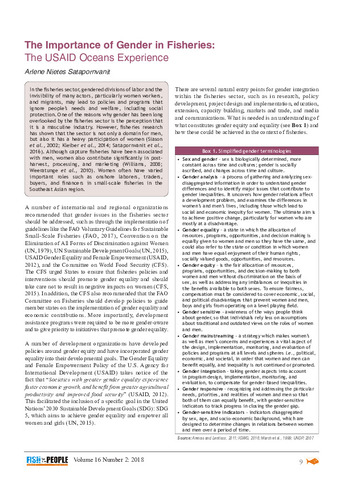The importance of gender in fisheries: The USAID Oceans experience
Share
| dc.contributor.author | Satapornvanit, Arlene Nietes | |
| dc.date.accessioned | 2018-08-15T05:50:52Z | |
| dc.date.available | 2018-08-15T05:50:52Z | |
| dc.date.issued | 2018 | |
| dc.identifier.citation | Satapornvanit, A. N. (2018). The importance of gender in fisheries: The USAID Oceans experience. Fish for the People, 16(2), 9-13. | en |
| dc.identifier.issn | 1685-6546 | |
| dc.identifier.uri | http://hdl.handle.net/20.500.12066/1377 | |
| dc.description.abstract | In the fisheries sector, gendered divisions of labor and the invisibility of many actors, particularly women workers, and migrants, may lead to policies and programs that ignore people’s needs and welfare, including social protection. One of the reasons why gender has been long overlooked by the fisheries sector is the perception that it is a masculine industry. However, fisheries research has shown that the sector is not only a domain for men, but also it has a heavy participation of women (Siason et al., 2002; Kleiber et al., 2014; Satapornvanit et al., 2016). Although capture fisheries have been associated with men, women also contribute significantly in postharvest, processing, and marketing (Williams, 2008; Weeratunge et al., 2010). Women often have varied important roles such as onshore laborers, traders, buyers, and financers in small-scale fisheries in the Southeast Asian region. | en |
| dc.language.iso | en | en |
| dc.publisher | Secretariat, Southeast Asian Fisheries Development Center | en |
| dc.subject | South East Asia | en |
| dc.title | The importance of gender in fisheries: The USAID Oceans experience | en |
| dc.type | magazineArticle | en |
| dc.citation.volume | 16 | |
| dc.citation.issue | 2 | |
| dc.citation.spage | 9 | |
| dc.citation.epage | 13 | |
| dc.citation.journalTitle | Fish for the People | en |
| dc.subject.asfa | fisheries | en |
| dc.subject.asfa | marketing | en |
| dc.subject.asfa | gender | en |
| dc.subject.asfa | Men | en |
| dc.subject.asfa | Oceans | en |
| dc.subject.asfa | women | en |
| dc.subject.asfa | labour | en |

